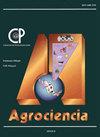上流式厌氧过滤器处理家禽污水的效率
IF 0.5
4区 农林科学
Q4 AGRICULTURE, MULTIDISCIPLINARY
引用次数: 0
摘要
家禽屠宰场排放的大量污水可以通过生物方法进行处理。这项研究的目的是评估以火山石(tezontle)为支撑介质的上流式厌氧过滤器(UAF)对家禽屠宰场污水的化学需氧量(COD)去除效率。根据墨西哥官方标准和标准方法进行了污水特征描述。支撑介质接种了城市污水处理厂的活性污泥。过滤器在连续流条件下运行,施加的容积负荷(AVL)分别为 1、1.5、2、2.5 和 3 kg COD m-3 d-1,水力停留时间(HRT)分别为 5.8、3.8、2.9、2.3 和 1.9 天。进行了方差分析(ANOVA),并使用 Krustall-Wallis 方法确定了每种 AVL 的显著差异。在逐步施用的厌氧实验室中,化学需氧量的去除率分别为 26.1%、53.2%、40.1%、17% 和 49.7%。然而,在 2 kg COD m-3 d-1 和 2.5 kg COD m-3 d-1 的 AVL 中,去除率有所下降,这是因为负荷增加导致系统不稳定。AVL 为 3 kg COD m-3 d-1 时,最大甲烷产量为 125 mL,甲烷产量(YCH4)为 0.082 LCH4 g-1 COD-1rem。由于在每个 AVL 条件下甲烷产量都没有增加,因此没有达到 0.328 LCH4 g-1 COD-1rem 的理论产量。上流式厌氧过滤器在处理家禽废水时表现出了很高的效率,对 COD 的最大去除率超过了 50%;不过,需要更多的适应时间才能在支撑介质中形成生物膜,这种预处理可去除高有机负荷并逐渐产生沼气。本文章由计算机程序翻译,如有差异,请以英文原文为准。
EFFICIENCY OF AN UPFLOW ANAEROBIC FILTER FOR POULTRY EFFLUENT TREATMENT
Poultry slaughterhouses discharge large quantities of effluents that can be treated biologically. The objective of this study was to evaluate the chemical oxygen demand (COD) removal efficiency of an upflow anaerobic filter (UAF) with effluents from a poultry slaughterhouse, using volcanic stone (tezontle) as a support medium. Effluent characterization was carried out in accordance with Mexican official standards and standard methods. The support medium was inoculated with activated sludge from an urban wastewater treatment plant. The filter was operated in continuous flow with applied volumetric loads (AVL) of 1, 1.5, 2, 2.5, and 3 kg COD m-3 d-1 and hydraulic retention times (HRT) of 5.8, 3.8, 2.9, 2.3, and 1.9 days. An analysis of variance (ANOVA) was performed, and significant differences were determined for each AVL using the Krustall-Wallis method. The results obtained in the gradually applied AVL were 26.1, 53.2, 40.1, 17, and 49.7 % COD removal. However, in the AVL of 2 and 2.5 kg COD m-3 d-1, there was a decrease in the removal, which is attributed to the destabilization of the system due to the increase in loads. The maximum methane production was 125 mL at an AVL of 3 kg COD m-3 d-1, with a methane yield (YCH4) of 0.082 LCH4 g-1 COD-1rem. With no increase in methane production at each AVL, the theoretical yield of 0.328 LCH4 g-1 COD-1rem. was not met. The upflow anaerobic filter demonstrated its efficiency with a poultry effluent, with maximum COD removal greater than 50 %; however, more acclimatization time is required for the formation of biofilm in the support medium, a pretreatment that removes the high organic load and allows for gradual biogas production.
求助全文
通过发布文献求助,成功后即可免费获取论文全文。
去求助
来源期刊

Agrociencia
农林科学-农业综合
CiteScore
0.50
自引率
33.30%
发文量
51
审稿时长
18-36 weeks
期刊介绍:
AGROCIENCIA is a scientific journal created and sponsored by the Colegio de Postgraduados. Its main objective is the publication and diffusion of agricultural, animal and forestry sciences research results from mexican and foreign scientists. All contributions are peer reviewed. Starting in the year 2000, AGROCIENCIA became a bimonthly and fully bilingual journal (Spanish and English versions in the same issue). Since 2007 appears every month and a half (eight issues per year). In addition to the printed issues, the full content is available in electronic format.
 求助内容:
求助内容: 应助结果提醒方式:
应助结果提醒方式:


